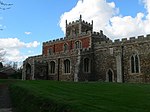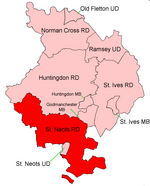Little Paxton Pits
Sites of Special Scientific Interest in Cambridgeshire

Little Paxton Pits is a 127.4-hectare (315-acre) biological Site of Special Scientific Interest in Little Paxton in Cambridgeshire. Part of it is also a 60 hectare Local Nature Reserve (LNR).These flooded former gravel pits are of national importance for wintering wildfowl, especially gadwalls. There are several nationally rare flies, such as Spilogona scutulata, Limnophora scrupulosa, Dolichopus andulusiacus and Lispocephala falculata. Flora include common spotted-orchids and hare’s-foot clover.There is access to the LNR from the High Street.
Excerpt from the Wikipedia article Little Paxton Pits (License: CC BY-SA 3.0, Authors, Images).Little Paxton Pits
Meadow Trail, Huntingdonshire Little Paxton
Geographical coordinates (GPS) Address Nearby Places Show on map
Geographical coordinates (GPS)
| Latitude | Longitude |
|---|---|
| N 52.258 ° | E -0.245 ° |
Address
Paxton Pits
Meadow Trail
PE19 6HQ Huntingdonshire, Little Paxton
England, United Kingdom
Open on Google Maps







